ocean currents
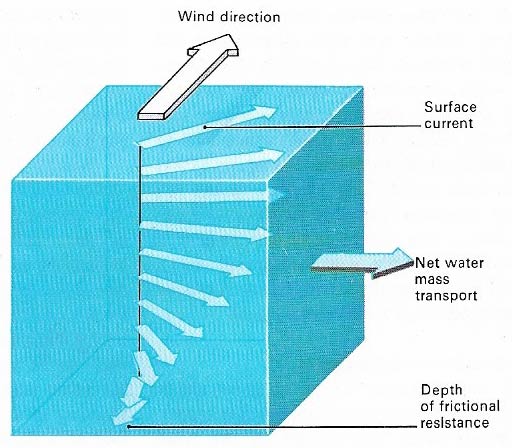
Figure 1. Surface currents are caused largely by prevailing winds The Coriolis effect results in the deflection of currents to the right of the wind direction in the northern hemisphere. In the same manner, the surface motion drives the subsurface layer at an angle to it, and so on. Each layer moves at a slower speed than the one above it and at a greater angle from the wind. The spiral created has the overall effect of moving the water mass above the depth of frictional resistance at an angle of about 90° from the wind direction.
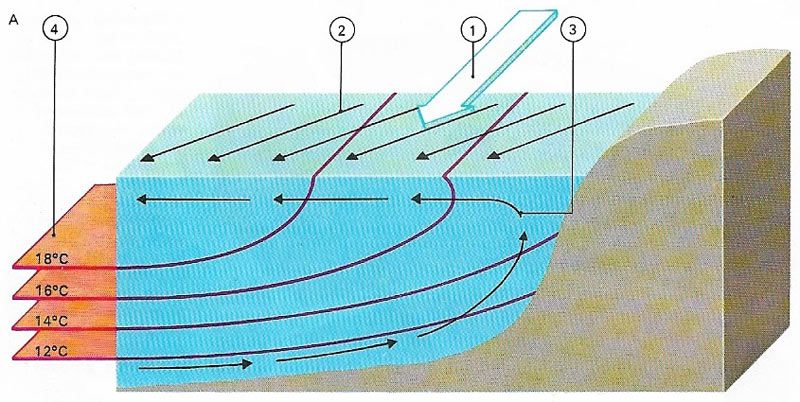
Figure 2. Upwelling (A) occurs when a longshore wind (1) pushes surface water away from a coast at an angle (2), allowing subsurface water to rise (3). This slow motion can best be seen as temperature gradients (4) as the deeper water is colder. Subsurface water often contains many nutrients and so areas where upwelling occurs are often exceptionally rich fishing grounds, such as off the west coast of South America (B).
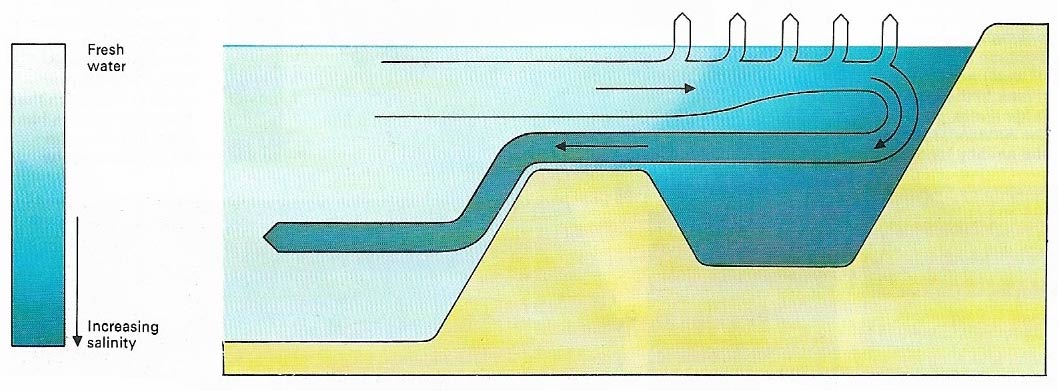
Figure 3. The water of the Mediterranean is constantly evaporating from its surface causing its salinity to increase. A current of normal salinity flows in and the excess salt is carried out by a deep-water current.
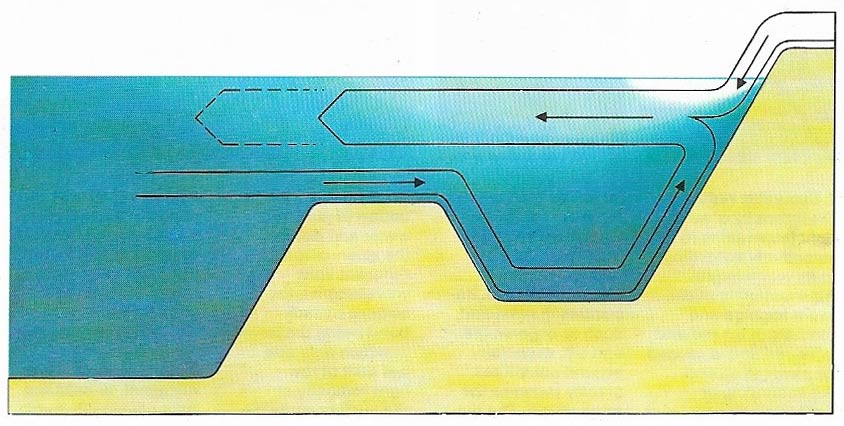
Figure 4. In the Baltic, a surface current of low salinity flows outward. The overall salinity of the Baltic is maintained by a small undercurrent bringing in as much salt as the amount that is carried away by the outflow.
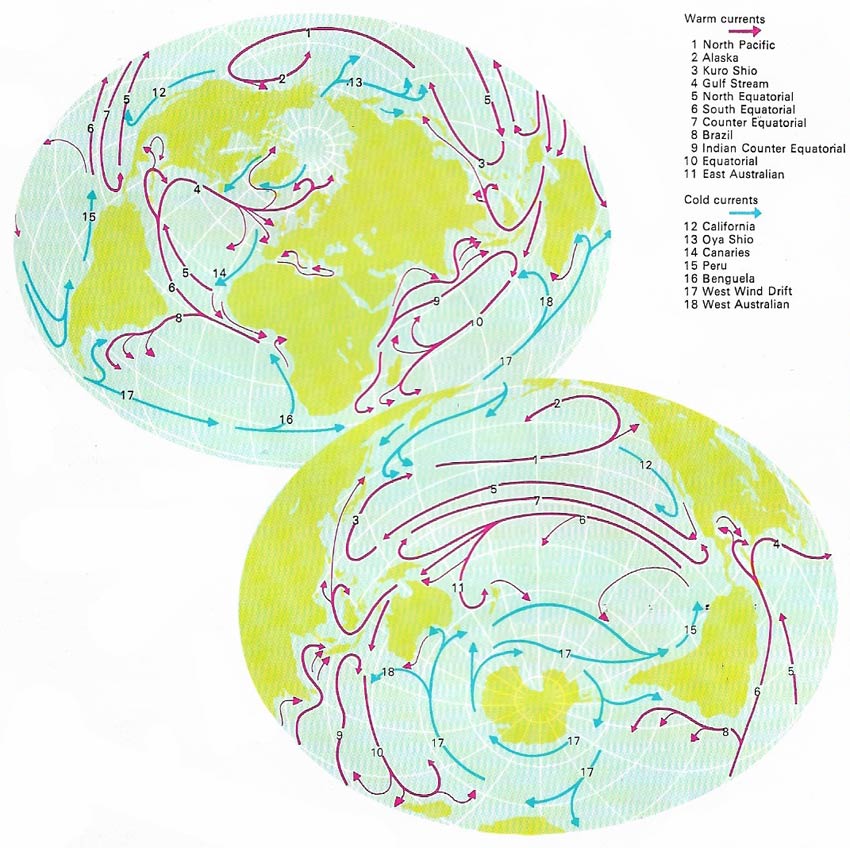
Figure 5. The surface currents of the world circulate in a clockwise direction in the northern hemisphere and in an anticlockwise direction in the southern hemisphere. These circulatory systems are called gyres. There are two large clockwise gyres in the northern hemisphere (in the North Atlantic and in the North Pacific) and three anticlockwise gyres in the southern hemisphere (in the South Atlantic, the South Pacific, and the Indian Ocean). Beneath the surface are undercurrents whose direction may be opposite to those at the surface. Beneath the northeastward flowing Gulf Stream off the eastern USA lies a large, cold current flowing south from the Arctic. The Gulf Stream finally splits in the North Atlantic, branching past eastern Greenland, northern Europe, and southern Europe, while part of the current returns southward to complete the gyre. Surface cold currents in the northern hemisphere generally flow southward. In the southern hemisphere, cold water circulates around Antarctica, while offshoots flow northward. The warm currents are very strong in tropical and sub-tropical regions. They include the Equatorial and Indian currents.
No part of the ocean is completely still, although, in the ocean depths, the movements of water is often extremely slow. Exploration of the deeper parts of the oceans has revealed the existence of marine life. If the water were not in motion, the oxygen – upon which life depends – would soon be used and not replaced. Life would therefore be impossible. The discovery that all ocean water moves is of great significance. It was once thought that dangerous radioactive wastes could be dumped in sealed containers in the ocean depths. If the containers were to corrode, the radioactive substances would be released into the water and gradually circulate around the globe, poisoning marine life.
Causes of ocean currents
Surface currents in the oceans have been recorded since ancient times and were used by early navigators. In 1947, Thor Heyerdahl sailed on his raft, the Kon-Tiki, from Peru to Tuamotu Islands east of Tahiti in 101 days. The journey, of nearly 7,000 kilometers (4,300 miles) was powered partly by the wind, but the raft was mainly carried by the Peru Current and the South Equatorial Current.
Prevailing winds sweep surface water along to form drift currents. These surface currents do not conform precisely with the direction of the prevailing wind because of the Coriolis effect causes by the rotation of the Earth. This effect, which increases away from the equator, makes currents in the northern hemisphere veer to the right of the wind direction and currents in the southern hemisphere veer to the left. The result is a general clockwise circulation of water in the northern hemisphere and an anticlockwise circulation in the southern hemisphere.
Other factors affecting currents are the configuration of the seabed and the shapes of land masses. For example, in the Atlantic Ocean, the North Equatorial Current flows toward the West Indies. Most of this current is channeled into the Gulf of Mexico where it veers northward, bursting into the Atlantic between Florida and Cuba as the Gulf Stream. (The term "stream" is used for currents with fairly clear boundaries.) This current, properly known as the Northern Atlantic Drift once it leaves the American coast, then flows at four to five knots in a northeasterly direction. However, even this marked current is confined to waters near the surface. At a depth of about 350 m ( (1,150 ft), its effect is hardly noticeable. In the late 1950s, another large current was discovered flowing under the Gulf Stream in the opposite direction.
Variation in density
The cause of currents that are not powered by winds are related to the density of ocean water, which varies according to temperature and salinity. Heating at the equator causes the water to become less dense. Cooling round the poles has the opposite effect. Salinity is affected by the inflow of fresh water from rivers, melting ice and rainfall, and by evaporation. For example, a high rate of evaporation in the Mediterranean Sea increases the salinity and therefore the density of water. As a result, currents of less dense (less salt) water flow into the Mediterranean from the Atlantic and the Black Sea. Smaller counter-currents of a higher density or salinity flow outward beneath these currents so that the salt content of the basin remains constant.
One of the simplest ways of measuring the speed and direction of surface currents is to record the movement of floating objects such as icebergs or wreckage. Ships record the flow of currents, sometimes by trailing a drift buoy and noting its movements. Current meters of many kinds are also used.
Effects of ocean currents
One of the most important effects of ocean currents is that they mix ocean water and so affect directly the fertility of the sea. Mixing is especially important when subsurface water is mixed with surface water. The upwelling of subsurface water may be caused by strong coastal winds that push the surface water outward, allowing subsurface water to rise up. Such upwelling occurs off the coasts of Peru, California, and Mauritania. Subsurface water rich in nutrients (notably phosphorus and silicon) rises to the surface, stimulating the growth of plankton which provides food for great shoals of fish, such as Peruvian anchovies. The anchovies are adversely affected by another current: when the winds fail, about the end of December, disaster occurs in the form of a warm current called El Niño which flows into the area, killing the cold-water plants and animals.
Water has a high heat capacity and can retain heat two and a half times as readily as land. The heat of the Sun absorbed by water around the equator is transported north and south by currents. Part of the North Atlantic Drift flows past Norway warming offshore winds and giving northwest Europe a winter temperature that is 11°C (20°F) above the average for those latitudes. The northward-flowing Peru and Benguela currents have a reverse effect, bringing cooler weather to the western coasts of South America and southern Africa. In such ways, currents have a profound effect on climate. Currents from polar regions can also create hazards for shipping. The Labrador and East Greenland currents carry icebergs and pack ice into shipping lanes and fog often occurs where cold and warm currents meet.


